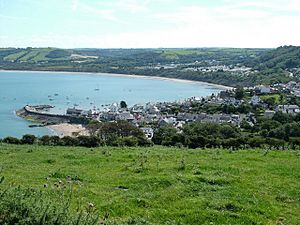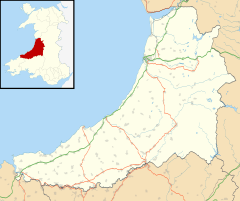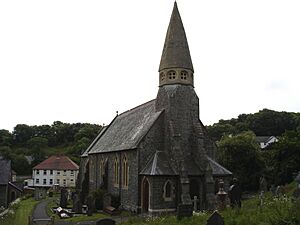New Quay facts for kids
Quick facts for kids New Quay
|
|
|---|---|
 New Quay |
|
| Population | 1,045 (2021) |
| • Cardiff | 90 mi (140 km)SE |
| Principal area | |
| Ceremonial county | |
| Country | Wales |
| Sovereign state | United Kingdom |
| Post town | New Quay |
| Postcode district | SA45 |
| Dialling code | 01545 |
| Police | Dyfed-Powys |
| Fire | Mid and West Wales |
| Ambulance | Welsh |
| EU Parliament | Wales |
| UK Parliament |
|
| Welsh Assembly |
|
New Quay (which is Cei Newydd in Welsh) is a lovely seaside town in Ceredigion, Wales. In 2021, about 1,045 people lived there. This town is located about 19 miles (31 km) south-west of Aberystwyth.
New Quay sits right on Cardigan Bay. It has a busy harbour and big sandy beaches. The town is also part of the Ceredigion Coast Path and the Wales Coast Path. It's still a popular place for holidays and a traditional fishing town. New Quay is also famous for its connections to the poet Dylan Thomas and his famous play, Under Milk Wood.
Contents
The History of New Quay
New Quay was once just a few small houses. These houses had thatched roofs and were surrounded by farms. The natural harbour was a safe spot for fishing boats. It also helped small trading ships.
How New Quay Grew as a Port
In 1834, a law called the New Quay Harbour Act was passed. This led to a stone pier being built. It cost £4,700, which was a lot of money back then! After the pier was built, more trade happened. People moved to New Quay for work. New houses were built for them.
Shipbuilding then started in the town. New Quay grew bigger. Terraced houses were built up the hills around the bay.
Shipbuilding and Seafaring Life
By the 1840s, over 300 men worked in shipbuilding. They built ships in three main areas. These were New Quay itself, Traethgwyn, and Cei-bach. They built small boats like smacks and schooners. These were used for sailing along the coast. They also built bigger ships. These larger ships sailed all the way to America and Australia.
At that time, New Quay had many important businesses. There were blacksmith shops, sail makers, and ropeworks. There was even a foundry for metalwork. Most men in the town worked on the sea. They also had jobs connected to the sea. Some old warehouses are still there today. They are now used for different things. You can still see chains, metal rings, and capstans outside the harbourmaster's office. There is also a list of fees for things brought in or sent out.
By 1870, shipbuilding in New Quay stopped. But most men still worked at sea. The town had schools to teach navigation. Many of the last square rigger ships were captained by men from New Quay. Between 1850 and 1927, 1,380 Merchant Master and Mate certificates were given to New Quay men. This shows how important seafaring was here.
In 1907, a local newspaper said New Quay had many retired sea captains. It had more than any other town its size in Wales. In 1939, 58 sailors lived in New Quay. Thirty of them were master mariners.
Learning and Tourism in New Quay
New Quay people were very keen on learning. A Newspaper Reading Room opened in 1854. It later became a library.
The first guide for tourists was published in 1885. It was called Guide to New Quay: Being a short description of New Quay as a Watering-place.
The 1904-1905 Welsh revival started in New Quay. This was a big religious movement.
Coronation Gardens were made in 1911. They are at the bottom of the town by the pier. They celebrated the crowning of King George V. A Memorial Hall was built in 1925. It remembered those who died in the First World War.
During World War II (1939-1945), students from the London Nautical School came to New Quay. They stayed in homes and hotels.
After the war, New Quay became a popular holiday spot.
How New Quay is Governed
New Quay is an electoral ward. This means it's an area that elects one person to the Ceredigion County Council. This has been happening since 1995.
Locally, New Quay has its own Town Council. This council has ten councillors.
Things to Do and See in New Quay
New Quay is a great place for holidays. People love the pretty harbour and wide sandy beaches. You can also take boat trips. These trips let you see the bottlenose dolphins that live in Cardigan Bay.
The town has a heritage centre and a marine wildlife centre. Near New Quay is the Honey Farm. It's the biggest bee farm in Wales. You can see a live bee exhibition there. They also sell honey, mead, and beeswax. There are many large holiday parks and caravan sites around the town.
Annual Events and Outdoor Activities
The annual Cardigan Bay Regatta happens in August. It has been going on since the 1870s. Today, it includes swimming and rowing races. There are also dinghy and cruiser boat races.
You can enjoy long walks on the beaches. There are also cliff walks along the Coastal Path. You can walk south to Llangrannog or north to Aberaeron.
Nearby Attractions for Families
The National Trust's Llanerchaeron estate is a short drive away. So is the 18th-century Ty Glyn Walled Garden in Ciliau Aeron.
Less than an hour away, you can find the ancient Pentre Ifan Burial Chamber. There is also the Castell Henllys Iron Age Village. You can ride restored steam trains from Aberystwyth. They go on a scenic route to Devil’s Bridge.
Local Services in New Quay
New Quay has shops, restaurants, and pubs. It also has a big primary school and a doctors' surgery. There is a small library branch and a fire station. The Memorial Hall is also a local facility.
There is a public park at the top of New Quay. It is next to the tennis court. The New Quay Bowling Club is on Francis Street.
Besides tourism, many people still work in sea fishing. They also work in processing fish.
New Quay Lifeboat Station
The New Quay Lifeboat Station is run by the RNLI. It has two lifeboats. One is a Mersey class boat. The other is a small inflatable D class boat. In 2014, the station celebrated 150 years of helping people. During that time, they went on 940 rescue missions.
Public Transport Options
Buses run regularly from New Quay. They go to Aberaeron, Cardigan, and Aberystwyth. New Quay has never had a train service. Plans for train lines were stopped a long time ago.
Dylan Thomas and New Quay
The famous poet Dylan Thomas and his wife, Caitlin Thomas, lived in New Quay. They stayed there from September 1944 to July 1945. They rented a small house called Majoda on a cliff. Dylan Thomas loved it. He said it was "in a really wonderful bit of the bay, with a beach of its own. Terrific."
The house was simple. It had no electricity, gas, or running water inside. The toilet and a water tap were outside. Caitlin said it was "cheaply primitive." They lived there during a very cold winter.
Dylan Thomas's Connections to New Quay
Many other families from Swansea lived in New Quay. They had moved there after Swansea was bombed in 1941. Dylan Thomas's friend and cousin, Vera Killick, lived next door. He also had an aunt and cousins in New Quay. Another relative was a famous World War I pilot, James Ira Thomas Jones.
Thomas had visited New Quay before. He came in the 1930s and again in 1942–43. During this time, he wrote a poem about a New Quay pub. He also wrote a script for a film about Cardigan Bay.
One of Thomas's supporters was Thomas Scott-Ellis, 8th Baron Howard de Walden. He owned Plas Llanina, a historic house nearby. He let Thomas use an old apple house in his garden to write. This place was very inspiring. Some people think stories about drowned houses and a cemetery nearby helped inspire Under Milk Wood.
New Quay as Inspiration for Under Milk Wood
Caitlin said New Quay was perfect for Dylan. He had "the ocean in front of him...and a pub where he felt at home." He was happy there. The ten months he spent at Majoda were very creative. His first biographer said it was a "great outpouring of poems."
These poems included the start of Fern Hill. They made up almost half of his book Deaths and Entrances. He also wrote four film scripts and a radio script. The radio script, Quite Early One Morning, was about a walk around New Quay. This script had many ideas and phrases later used in Under Milk Wood. Dylan Thomas had not written so much since he was a teenager.
Many people believe New Quay inspired the village of Llareggub in Under Milk Wood. One expert said New Quay was "crucial" for the characters Thomas used. Another said Llareggub looks like New Quay. The play's producer, Douglas Cleverdon, noted that Thomas's inspiration seemed to fade when he left New Quay. One of Thomas's closest friends said the play was mostly written in New Quay, not Laugharne.
Jack Patrick Evans, who ran the Black Lion pub in New Quay, said Thomas gathered ideas there. He was "always busy, making notes of any local characters who came in."
Characters and Places from New Quay in the Play
Thomas's drawing of Llareggub is based on New Quay. He even used the name of a real New Quay resident, Cherry Jones, for a character. He also combined names of other New Quay residents for characters like Mrs Ogmore-Pritchard.
Jack Lloyd Evans, a New Quay postman and Town Crier, inspired the character Willy Nilly. Willy Nilly opens letters and shares the news. This was like Jack Lloyd's job as Town Crier. Dylan Thomas knew Jack Lloyd well.
Other New Quay people appear in the play too. Dai Fred Davies, a donkeyman on a fishing boat, became Tom-Fred. Even small details from New Quay are in the play. For example, the question "Buttermilk and whippets?" refers to Jack Patrick, the pub landlord, who kept whippets and made buttermilk.
The play also mentions "the tenors in Dowlais." This shows the link between New Quay and Dowlais. Workers from Dowlais often came to New Quay for holidays. They would sing on the pier. When a church in Dowlais was taken down, its bell was given to New Quay's church.
Other New Quay names and places in the play include Maesgwyn farm, the Sailor's Home Arms, the river Dewi, the quarry, the harbour, Manchester House, the hill of windows, and the Downs.
The jobs of people in Llareggub also match New Quay. Llareggub has sailors, fishermen, and farmers. New Quay's job profile fits this very well.
A writer named Walter Wilkinson visited New Quay in 1947. His essay describes the town as Thomas would have seen it. There is also an old ITV film from 1959. It shows the town and its people during the summer holidays.
The Edge of Love Film and the Dylan Thomas Trail
Much of the film The Edge of Love was shot in New Quay. This 2008 film is about Dylan and Caitlin Thomas. It starred famous actors like Sienna Miller and Keira Knightley. The scriptwriter said the film was mostly made up. However, one event was real: an incident at Majoda in March 1945.
The Dylan Thomas Trail goes through Ceredigion. It has a walking guide. Dylan and Caitlin's daughter, Aeronwy Thomas, opened it in 2003. The trail has blue plaques and information boards. There are also walks like the Rev. Eli Jenkins' Pub Walk.
Dylan Thomas and his family left New Quay in July 1945. But he still wanted to live there again. He came back at least twice in 1946. He wrote about the "gently swilling retired sea-captains" in the Black Lion pub. He also met jazz pianist Dill Jones in another pub. Thomas's letters show he knew many interesting people in New Quay.
He mentioned New Quay in a 1949 radio show. He also stayed in touch with a New Quay friend, Skipper Rymer, in 1953.
Other Famous People from New Quay
- Towyn Jones (1858–1925): A clergyman and politician.
- John Tywi Jones (1870-1948): A Baptist minister, journalist, and playwright.
- Elizabeth Mary Jones (‘Moelona’, 1877–1953): A teacher, novelist, and translator.
- Florrie Evans (1884–1967): A local resident who helped start the 1904 Welsh Christian revival in New Quay. She became a preacher and missionary.
- Geraint Bowen (1915–2011): A Welsh language poet and campaigner.
- Dill Jones (1923–1984): A jazz pianist.
- Angharad Taris (born 1964): An artist.
- Samantha Wynne Rhydderch (born 1966): A poet.
- Francesca Rhydderch (born 1969): A writer and academic.
- Ryan Andrews (born 1981): A film director.
Plas Llanina: A Historic House
Plas Llanina is about a mile north of New Quay. It sits on cliffs above Traethgwyn and Cei Bach beaches. It is a good example of an old gentry house. It has a long history with interesting owners and stories.
The Musgrave family owned it from around 1630. Later, it went to the Jones family. Then, it passed to the Longcroft family until about 1920. One famous owner was Air Vice Marshal Sir Charles Alexander Holcombe Longcroft. He was born there and helped create the Royal Air Force.
In the late 1930s, Lord Howard de Walden rented the house. He used it as a summer home. In the late 1940s, it was bought by Colonel J. J. Davis and Betty Davis. By 1964, Plas Llanina was falling apart. It was bought and rebuilt in 1988 by a banker from London.
The house is next to the church of Saint Ina. There is a public path to both the church and the beach.
Images for kids
See also
 In Spanish: New Quay para niños
In Spanish: New Quay para niños





